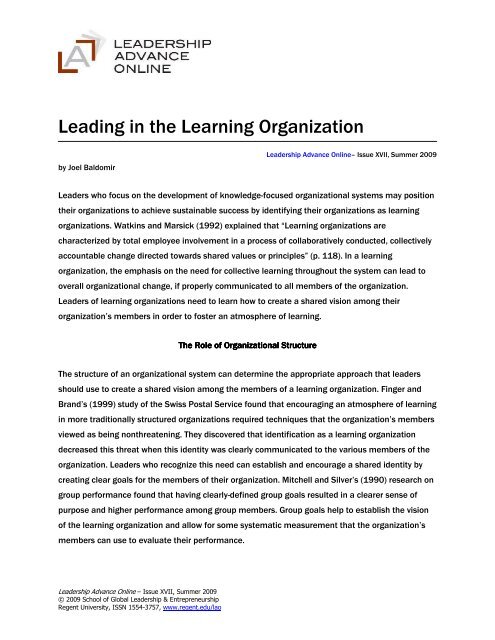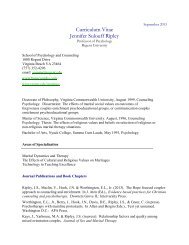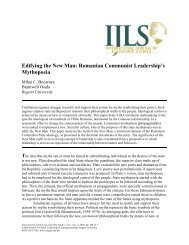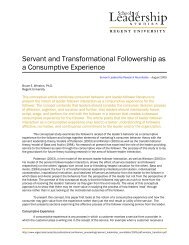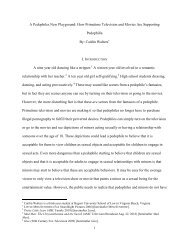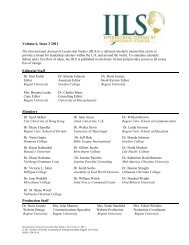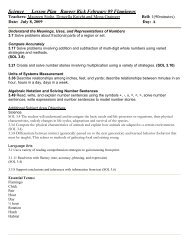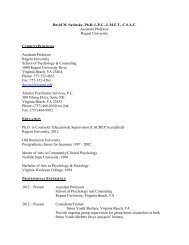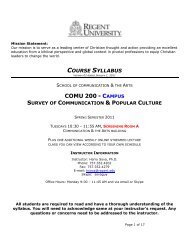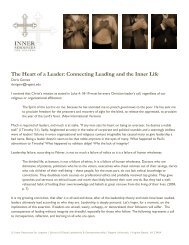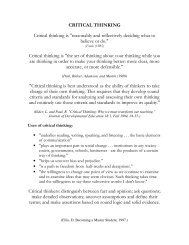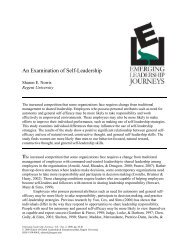Leading in the Learning Organization - Regent University
Leading in the Learning Organization - Regent University
Leading in the Learning Organization - Regent University
You also want an ePaper? Increase the reach of your titles
YUMPU automatically turns print PDFs into web optimized ePapers that Google loves.
<strong>Lead<strong>in</strong>g</strong> <strong>in</strong> <strong>the</strong> Learn<strong>in</strong>g <strong>Organization</strong><br />
by Joel Baldomir<br />
Leadership Advance Onl<strong>in</strong>e – Issue XVII, Summer 2009<br />
© 2009 School of Global Leadership & Entrepreneurship<br />
<strong>Regent</strong> <strong>University</strong>, ISSN 1554-3757, www.regent.edu/lao<br />
Leadership Advance Onl<strong>in</strong>e– Issue XVII, Summer 2009<br />
Leaders who focus on <strong>the</strong> development of knowledge-focused organizational systems may position<br />
<strong>the</strong>ir organizations to achieve susta<strong>in</strong>able success by identify<strong>in</strong>g <strong>the</strong>ir organizations as learn<strong>in</strong>g<br />
organizations. Watk<strong>in</strong>s and Marsick (1992) expla<strong>in</strong>ed that “Learn<strong>in</strong>g organizations are<br />
characterized by total employee <strong>in</strong>volvement <strong>in</strong> a process of collaboratively conducted, collectively<br />
accountable change directed towards shared values or pr<strong>in</strong>ciples” (p. 118). In a learn<strong>in</strong>g<br />
organization, <strong>the</strong> emphasis on <strong>the</strong> need for collective learn<strong>in</strong>g throughout <strong>the</strong> system can lead to<br />
overall organizational change, if properly communicated to all members of <strong>the</strong> organization.<br />
Leaders of learn<strong>in</strong>g organizations need to learn how to create a shared vision among <strong>the</strong>ir<br />
organization’s members <strong>in</strong> order to foster an atmosphere of learn<strong>in</strong>g.<br />
The The The Role Role of of <strong>Organization</strong>al <strong>Organization</strong>al Str Structure Str Str ucture<br />
The structure of an organizational system can determ<strong>in</strong>e <strong>the</strong> appropriate approach that leaders<br />
should use to create a shared vision among <strong>the</strong> members of a learn<strong>in</strong>g organization. F<strong>in</strong>ger and<br />
Brand’s (1999) study of <strong>the</strong> Swiss Postal Service found that encourag<strong>in</strong>g an atmosphere of learn<strong>in</strong>g<br />
<strong>in</strong> more traditionally structured organizations required techniques that <strong>the</strong> organization’s members<br />
viewed as be<strong>in</strong>g nonthreaten<strong>in</strong>g. They discovered that identification as a learn<strong>in</strong>g organization<br />
decreased this threat when this identity was clearly communicated to <strong>the</strong> various members of <strong>the</strong><br />
organization. Leaders who recognize this need can establish and encourage a shared identity by<br />
creat<strong>in</strong>g clear goals for <strong>the</strong> members of <strong>the</strong>ir organization. Mitchell and Silver’s (1990) research on<br />
group performance found that hav<strong>in</strong>g clearly-def<strong>in</strong>ed group goals resulted <strong>in</strong> a clearer sense of<br />
purpose and higher performance among group members. Group goals help to establish <strong>the</strong> vision<br />
of <strong>the</strong> learn<strong>in</strong>g organization and allow for some systematic measurement that <strong>the</strong> organization’s<br />
members can use to evaluate <strong>the</strong>ir performance.
2<br />
<strong>Lead<strong>in</strong>g</strong> <strong>in</strong> <strong>the</strong> Learn<strong>in</strong>g <strong>Organization</strong><br />
Like F<strong>in</strong>ger and Brand (1999), Wheatley (2001) expla<strong>in</strong>ed that many of <strong>the</strong> organizational systems<br />
that exist are left over from an antiquated approach to leadership where reductionist, l<strong>in</strong>ear<br />
th<strong>in</strong>k<strong>in</strong>g allows for only a limited view of an organization’s needs. She added that a strict<br />
hierarchal-structured organizational system might do little to encourage members of <strong>the</strong><br />
organization to work toge<strong>the</strong>r with<strong>in</strong> an organizational structure. By recogniz<strong>in</strong>g that <strong>the</strong><br />
organization exists to provide a means of develop<strong>in</strong>g a collaborative perspective, <strong>the</strong> members of<br />
an organization might be better positioned to work toge<strong>the</strong>r and acknowledge <strong>the</strong>ir need to be a<br />
part of <strong>the</strong> knowledge system (Tsoukas & Mylonopoulos, 2004).<br />
K<strong>in</strong>g and Marks (2008) studied <strong>the</strong> dynamics of a knowledge system with<strong>in</strong> <strong>the</strong> context of a<br />
hierarchal-structured government organization. They found that although <strong>the</strong> development of a<br />
knowledge-shar<strong>in</strong>g culture has been viewed as someth<strong>in</strong>g that is sought after by many<br />
organizations, <strong>the</strong> success of <strong>the</strong> system may also be dependent on <strong>the</strong> structure of <strong>the</strong><br />
organization itself. The structure and culture of an organization are factors that should determ<strong>in</strong>e<br />
<strong>the</strong> strategies used by organizational leaders (Yukl, 2006). With<strong>in</strong> a learn<strong>in</strong>g organization, <strong>the</strong><br />
leaders must be commitment to study<strong>in</strong>g <strong>the</strong>ir organization and add<strong>in</strong>g to <strong>the</strong>ir own knowledge <strong>in</strong><br />
order to effectively encourage <strong>the</strong> learn<strong>in</strong>g acquisition of <strong>the</strong>ir followers. It is <strong>the</strong> leadership of <strong>the</strong><br />
learn<strong>in</strong>g organization that is charged with <strong>the</strong> task of equipp<strong>in</strong>g <strong>the</strong>ir followers so as to allow for<br />
<strong>in</strong>dividual growth and development with<strong>in</strong> <strong>the</strong> collaborative dynamic of <strong>the</strong> organizational system.<br />
Leadership Advance Onl<strong>in</strong>e – Issue XVII, Summer 2009<br />
© 2009 School of Global Leadership & Entrepreneurship<br />
<strong>Regent</strong> <strong>University</strong>, ISSN 1554-3757, www.regent.edu/lao<br />
The The The Need Need for for a a Shared Shared Vision<br />
Vision<br />
Leaders of learn<strong>in</strong>g organizations can best achieve cooperation or group collaboration through a<br />
process of creat<strong>in</strong>g a shared vision and clear purpose (Eisenberg & Goodall, 2007). Communicat<strong>in</strong>g<br />
a shared vision is key to unit<strong>in</strong>g <strong>the</strong> various members of an organization; this allows <strong>the</strong>m to<br />
redirect <strong>the</strong>ir attention from <strong>the</strong>ir own <strong>in</strong>dividual positions to <strong>the</strong> greater good of <strong>the</strong> organization<br />
(Wheatley, 2001). Senge (1990) found that for an organizational system to function effectively,<br />
members of an organization needed to ignore <strong>the</strong>ir own <strong>in</strong>dividual assumptions and strive to<br />
become a collective unit that th<strong>in</strong>ks toge<strong>the</strong>r. The desire to ga<strong>in</strong> an organizational body of<br />
knowledge establishes <strong>the</strong> importance of <strong>the</strong> learn<strong>in</strong>g organization and creates a shared vision that<br />
can unite <strong>the</strong> members of <strong>the</strong> learn<strong>in</strong>g organization. Clearly understand<strong>in</strong>g and communicat<strong>in</strong>g <strong>the</strong><br />
need for <strong>the</strong> members of a learn<strong>in</strong>g organization to abandon <strong>the</strong>ir own self <strong>in</strong>terests <strong>in</strong> favor of a<br />
higher organizational goal of collective learn<strong>in</strong>g is a strategy that will allow leaders to better
Leadership Advance Onl<strong>in</strong>e – Issue XVII, Summer 2009<br />
© 2009 School of Global Leadership & Entrepreneurship<br />
<strong>Regent</strong> <strong>University</strong>, ISSN 1554-3757, www.regent.edu/lao<br />
Leadership Advance Onl<strong>in</strong>e – Summer 2009 3<br />
prepare an organization’s members to prosper with<strong>in</strong> <strong>the</strong> organizational system, as well as with<strong>in</strong><br />
<strong>the</strong>ir specific <strong>in</strong>dustrial field (Wheatley, 2001).<br />
Shar<strong>in</strong>g Shar<strong>in</strong>g Information<br />
Information<br />
For a learn<strong>in</strong>g organization to prosper and grow with<strong>in</strong> <strong>the</strong>ir field, organizational leaders need to act<br />
<strong>in</strong> a manner that encourages <strong>the</strong> shar<strong>in</strong>g of <strong>in</strong>formation between all of <strong>the</strong> members of <strong>the</strong><br />
organization (Treleaven, 2004). Senge (1990) found that articulat<strong>in</strong>g <strong>the</strong> importance of <strong>the</strong> shar<strong>in</strong>g<br />
of <strong>in</strong>formation is vital to <strong>the</strong> success of any organization. An effective organizational system is one<br />
that is adaptive, allow<strong>in</strong>g all of its members to feel valued and empowered to accomplish any<br />
needed tasks (Wheatley, 2001). Willett (1999) went so far as to argue that an organization’s<br />
members cannot behave responsibly unless <strong>the</strong>y are given access to <strong>the</strong> knowledge that is ga<strong>in</strong>ed<br />
from o<strong>the</strong>rs <strong>in</strong> <strong>the</strong> organizational system. In learn<strong>in</strong>g organizations, grant<strong>in</strong>g members access to<br />
<strong>the</strong> <strong>in</strong>formation with<strong>in</strong> <strong>the</strong> system is necessary for <strong>the</strong> successful adaptation of all of <strong>the</strong> members<br />
of <strong>the</strong> organization.<br />
Creat<strong>in</strong>g Creat<strong>in</strong>g Knowledge Knowledge L<strong>in</strong>ks<br />
L<strong>in</strong>ks<br />
The shar<strong>in</strong>g of <strong>in</strong>formation is a key characteristic of a learn<strong>in</strong>g organization. Bogenrieder and<br />
Nooteboom (2004) expla<strong>in</strong>ed that with<strong>in</strong> an organizational, <strong>the</strong>re is a need to establish knowledge<br />
l<strong>in</strong>ks between <strong>the</strong> members of <strong>the</strong> organization and <strong>the</strong> organization as a whole. They fur<strong>the</strong>r<br />
expla<strong>in</strong>ed that <strong>the</strong> knowledge ga<strong>in</strong>ed by <strong>the</strong> <strong>in</strong>dividual must be tied <strong>in</strong> to <strong>the</strong> knowledge ga<strong>in</strong>ed by<br />
<strong>the</strong> collective organization. In learn<strong>in</strong>g organizations, develop<strong>in</strong>g relationships between <strong>the</strong><br />
members of <strong>the</strong> system can form <strong>the</strong>se knowledge l<strong>in</strong>ks. A person’s true effectiveness <strong>in</strong> an<br />
organization should <strong>the</strong>refore be measured based on his or her relationships with o<strong>the</strong>r<br />
organization members ra<strong>the</strong>r than on his or her <strong>in</strong>dividual accomplishments (Wheatley, 2001). The<br />
<strong>in</strong>dividual relationships with<strong>in</strong> <strong>the</strong> learn<strong>in</strong>g organization are fur<strong>the</strong>r streng<strong>the</strong>ned by <strong>the</strong> creation of<br />
smaller learn<strong>in</strong>g communities. This approach forms a symbiotic relationship between <strong>the</strong> <strong>in</strong>dividual<br />
and <strong>the</strong> organization, thus establish<strong>in</strong>g <strong>the</strong> importance of cooperative collaboration with<strong>in</strong> learn<strong>in</strong>g<br />
organizations (Bogenrieder & Nooteboom, 2004).
4<br />
<strong>Lead<strong>in</strong>g</strong> <strong>in</strong> <strong>the</strong> Learn<strong>in</strong>g <strong>Organization</strong><br />
Leadership Advance Onl<strong>in</strong>e – Issue XVII, Summer 2009<br />
© 2009 School of Global Leadership & Entrepreneurship<br />
<strong>Regent</strong> <strong>University</strong>, ISSN 1554-3757, www.regent.edu/lao<br />
Communicat<strong>in</strong>g Communicat<strong>in</strong>g Purpose<br />
Purpose<br />
A leader’s ability to effectively communicate <strong>the</strong> purpose of certa<strong>in</strong> tasks is essential to<br />
ma<strong>in</strong>ta<strong>in</strong><strong>in</strong>g collaborative learn<strong>in</strong>g with<strong>in</strong> a learn<strong>in</strong>g organization. Hertel, Niedner and Herrmann’s<br />
(2003) study of L<strong>in</strong>ux software developers found that clear identification and communication of<br />
one’s specific purpose with<strong>in</strong> a system could lead to <strong>the</strong> successful completion of organizational<br />
tasks. The study focused on 141 software developers work<strong>in</strong>g on a large open source project. The<br />
nature of this particular project made it necessary for <strong>the</strong> software developers to focus on both<br />
<strong>the</strong>ir own <strong>in</strong>dividual knowledge and <strong>the</strong> collective knowledge ga<strong>in</strong>ed form <strong>the</strong>ir project team<br />
(Hertel, Niedner & Herrmann, 2003). Their own identification as L<strong>in</strong>ux developers work<strong>in</strong>g toge<strong>the</strong>r<br />
on a larger task allowed <strong>the</strong>m to communicate and share <strong>the</strong>ir f<strong>in</strong>d<strong>in</strong>gs with <strong>the</strong>ir fellow<br />
teammates, thus creat<strong>in</strong>g an open, collaborative, learn<strong>in</strong>g-focused system. With<strong>in</strong> learn<strong>in</strong>g<br />
organizations, leaders should encourage this level of open communication.<br />
Th<strong>in</strong>k<strong>in</strong>g Th<strong>in</strong>k<strong>in</strong>g Long Long Term Term<br />
Term<br />
Leaders of learn<strong>in</strong>g organizations also need to look beyond <strong>the</strong> short-sighted perspectives that<br />
prevent some organizational leaders from embrac<strong>in</strong>g <strong>the</strong> concept of <strong>the</strong> learn<strong>in</strong>g organization. The<br />
perceived lack of practicality and additional time <strong>in</strong>vestment often impact an organizational<br />
leader’s decisions concern<strong>in</strong>g <strong>the</strong> creation of learn<strong>in</strong>g organizations (Cremer, Garicano & Prat,<br />
2007). Issues of cost and competition may, <strong>in</strong> <strong>the</strong> short term, make it seem undesirable for some<br />
leaders to embrace <strong>the</strong> concept of a learn<strong>in</strong>g organization, but as Senge (1990) po<strong>in</strong>ted out, <strong>the</strong><br />
return may not be immediately seen because most knowledge systems are, “generally oriented<br />
toward a long-term view” (p. 92). The learn<strong>in</strong>g organization needs leaders who possess <strong>the</strong> ability to<br />
look beyond <strong>the</strong> immediate organizational tasks and focus on <strong>the</strong> greater good that comes from<br />
<strong>the</strong> collective purpose of seek<strong>in</strong>g knowledge that will benefit <strong>the</strong> organization as a whole.<br />
Conclusion<br />
Conclusion<br />
Ma<strong>in</strong>ta<strong>in</strong><strong>in</strong>g <strong>the</strong> effectiveness of a learn<strong>in</strong>g organization requires <strong>the</strong> total commitment of <strong>the</strong><br />
leadership and all of <strong>the</strong> o<strong>the</strong>r members of <strong>the</strong> organization. The successful organizational leader is<br />
able to move <strong>the</strong> organization toward becom<strong>in</strong>g a true learn<strong>in</strong>g organization by establish<strong>in</strong>g a<br />
shared organizational identity and is able to clearly convey this identity to all members of <strong>the</strong><br />
organization. Effective leaders of learn<strong>in</strong>g organizations are those <strong>in</strong>dividuals who encourage <strong>the</strong>
Leadership Advance Onl<strong>in</strong>e – Issue XVII, Summer 2009<br />
© 2009 School of Global Leadership & Entrepreneurship<br />
<strong>Regent</strong> <strong>University</strong>, ISSN 1554-3757, www.regent.edu/lao<br />
Leadership Advance Onl<strong>in</strong>e – Summer 2009 5<br />
pursuit of <strong>in</strong>dividual and organizational knowledge by creat<strong>in</strong>g a shared vision of <strong>the</strong> future of <strong>the</strong><br />
organization. They possess <strong>the</strong> ability to identify <strong>the</strong> role that each <strong>in</strong>dividual member plays <strong>in</strong> <strong>the</strong><br />
organizational system and allow for <strong>the</strong> open exchange of <strong>in</strong>formation between all members. These<br />
are <strong>the</strong> skills that will allow leaders to be successful with<strong>in</strong> learn<strong>in</strong>g organizations.<br />
About About About <strong>the</strong> <strong>the</strong> <strong>the</strong> Author<br />
Author<br />
Joel Baldomir is an <strong>in</strong>structor at Nyack College’s School of Bus<strong>in</strong>ess & Leadership and an adjunct<br />
<strong>in</strong>structor of communication at Dom<strong>in</strong>ican College. He is currently work<strong>in</strong>g toward a Ph.D. <strong>in</strong><br />
<strong>Organization</strong>al Leadership at <strong>Regent</strong> <strong>University</strong>’s School of Global Leadership & Entrepreneurship.<br />
Email: joelbal@regent.edu<br />
joelbal@regent.edu<br />
References<br />
References<br />
Bogenrieder, I., & Nooteboom, B. (2004). The emergence of learn<strong>in</strong>g communities: A <strong>the</strong>oretical<br />
analysis. In H. Tsoukas, & N. Mylonopoulos (Eds.), <strong>Organization</strong>s as knowledge systems:<br />
Knowledge, learn<strong>in</strong>g and dynamic capabilities. New York: Palgrave Macmillan.<br />
Cremer, J., Garicano, L., & Prat, A. (2007). Language and <strong>the</strong> <strong>the</strong>ory of <strong>the</strong> firm. Quarterly Journal of<br />
Economics, 122 (1), pp. 373-407.<br />
Eisenberg, E. M., & Goodall, H. L. (2007). <strong>Organization</strong>al communication. Boston, MA: Bedford St.<br />
Mart<strong>in</strong>’s.<br />
F<strong>in</strong>ger, M., & Brand, S. B. (1999). The concept of <strong>the</strong> ‘learn<strong>in</strong>g organization’ applied to <strong>the</strong><br />
transformation of <strong>the</strong> public sector. In M. Easterby-Smith, L. Araujo, & J. Burgoyne (Eds.),<br />
<strong>Organization</strong>al learn<strong>in</strong>g and <strong>the</strong> learn<strong>in</strong>g organization. London: Sage.<br />
Hertel, G., Niedner, S., & Herrmann, S. (2003). Motivation of software developers <strong>in</strong> open source<br />
projects: An Internet-based survey of contributors to <strong>the</strong> L<strong>in</strong>ux kernel. Research Policy,<br />
32(7), pp. 1159-1177.<br />
K<strong>in</strong>g, W., & Marks, P. (2008). Motivat<strong>in</strong>g knowledge shar<strong>in</strong>g through a knowledge management<br />
system. Omega, 36(1), pp. 131-146.<br />
Mitchell, T., & Silver, W. (1990). Individual and group goals when workers are <strong>in</strong>terdependent:<br />
Effects on task strategies and performance. Journal of Applied Psychology, 75, pp. 185-<br />
193.
6<br />
<strong>Lead<strong>in</strong>g</strong> <strong>in</strong> <strong>the</strong> Learn<strong>in</strong>g <strong>Organization</strong><br />
Senge, P. M. (1990). The Fifth Discipl<strong>in</strong>e: The art and practice of <strong>the</strong> learn<strong>in</strong>g organization. London:<br />
Random House.<br />
Treleaven, L. (2004). A knowledge-shar<strong>in</strong>g approach to organizational change: A critical discourse<br />
analysis. In H. Tsoukas, & N. Mylonopoulos (Eds.), <strong>Organization</strong>s as knowledge systems:<br />
Knowledge, learn<strong>in</strong>g and dynamic capabilities. New York: Palgrave Macmillan.<br />
Tsoukas, H., & Mylonopoulos, N. (2004). <strong>Organization</strong>s as knowledge systems: Knowledge, learn<strong>in</strong>g<br />
and dynamic capabilities. New York: Palgrave Macmillan.<br />
Watk<strong>in</strong>s, K., & Marsick, V. (1992). Build<strong>in</strong>g <strong>the</strong> learn<strong>in</strong>g organization: A new role for human<br />
resource developers. Studies <strong>in</strong> Cont<strong>in</strong>u<strong>in</strong>g Education, 14(2), pp. 115-29.<br />
Weick, K., & Westley, F. (1996). <strong>Organization</strong>al learn<strong>in</strong>g: Affirm<strong>in</strong>g an oxymoron. In S. Clegg, C.<br />
Hardy, & W. R. Nord (Eds.), Handbook of organization studies. London: Sage.<br />
Wheatley, M. (2001). Leadership and <strong>the</strong> new science: Discover<strong>in</strong>g order <strong>in</strong> a chaotic world. New<br />
York: Berrett-Koehler Publishers.<br />
Willett, C. (1999). Knowledge shar<strong>in</strong>g shifts <strong>the</strong> power paradigm. In M. Maybury, D. Morey, &<br />
B. Thurais<strong>in</strong>gham (Eds.), Knowledge management: Classic and contemporary works.<br />
Cambridge, MA: MIT Press.<br />
Yukl, G. (2006). Leadership <strong>in</strong> organizations (6th ed.). Upper Saddle River, NJ: Prentice Hall.<br />
Leadership Advance Onl<strong>in</strong>e – Issue XVII, Summer 2009<br />
© 2009 School of Global Leadership & Entrepreneurship<br />
<strong>Regent</strong> <strong>University</strong>, ISSN 1554-3757, www.regent.edu/lao


